Fangcheng Fu
SALE : Low-bit Estimation for Efficient Sparse Attention in Long-context LLM Prefilling
May 30, 2025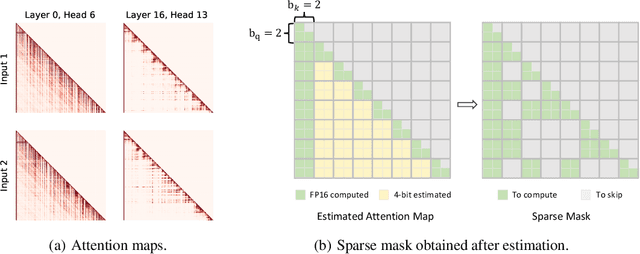
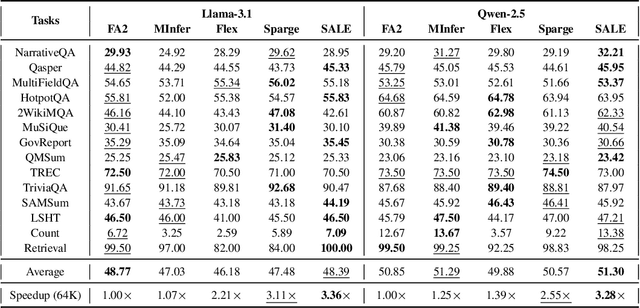

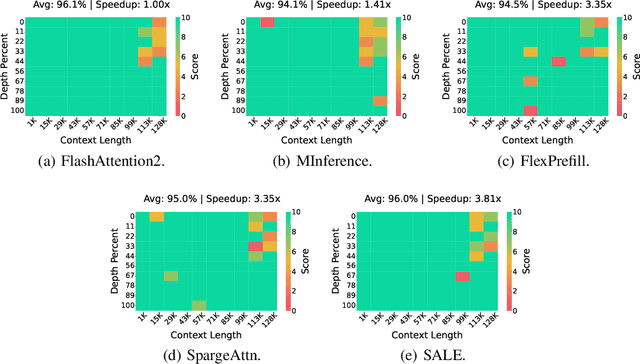
Abstract:Many advanced Large Language Model (LLM) applications require long-context processing, but the self-attention module becomes a bottleneck during the prefilling stage of inference due to its quadratic time complexity with respect to sequence length. Existing sparse attention methods accelerate attention computation by skipping less significant regions of the attention map. However, these approaches typically perform coarse-grained inspection of the attention map, rendering considerable loss in model accuracy. In this paper, we propose SALE, a fine-grained sparse attention method that accelerates the long-context prefilling stage of LLM with negligible loss in model accuracy. SALE achieves fast and accurate fine-grained attention weight estimation through 4-bit quantized query-key products, followed by block-sparse attention to accelerate prefilling computations. For importance evaluation for query-key pairs, we adopt our Relative Attention Score metric, which offers significantly higher efficiency within our framework. We implement a custom CUDA kernel optimized for our approach for hardware efficiency, reducing the additional overhead to approximately 11% of the full attention latency. Notably, SALE requires no parameter training and can be seamlessly integrated into existing systems with trivial code modifications. Experiments on long-context benchmarks demonstrate that our method outperforms existing approaches in accuracy-efficiency trade-offs, achieving at least 3.36x speedups on Llama-3.1-8B for sequences longer than 64K while maintaining model quality.
Thinking Short and Right Over Thinking Long: Serving LLM Reasoning Efficiently and Accurately
May 19, 2025Abstract:Recent advances in test-time scaling suggest that Large Language Models (LLMs) can gain better capabilities by generating Chain-of-Thought reasoning (analogous to human thinking) to respond a given request, and meanwhile exploring more reasoning branches (i.e., generating multiple responses and ensembling them) can improve the final output quality. However, when incorporating the two scaling dimensions, we find that the system efficiency is dampened significantly for two reasons. Firstly, the time cost to generate the final output increases substantially as many reasoning branches would be trapped in the over-thinking dilemma, producing excessively long responses. Secondly, generating multiple reasoning branches for each request increases memory consumption, which is unsuitable for LLM serving since we can only batch a limited number of requests to process simultaneously. To address this, we present SART, a serving framework for efficient and accurate LLM reasoning. The essential idea is to manage the thinking to be short and right, rather than long. For one thing, we devise a redundant sampling with early stopping approach based on empirical observations and theoretic analysis, which increases the likelihood of obtaining short-thinking responses when sampling reasoning branches. For another, we propose to dynamically prune low-quality branches so that only right-thinking branches are maintained, reducing the memory consumption and allowing us to batch more requests. Experimental results demonstrate that SART not only improves the accuracy of LLM reasoning but also enhances the serving efficiency, outperforming existing methods by up to 28.2 times and on average 15.7 times in terms of efficiency when achieving the same level of accuracy.
Galvatron: An Automatic Distributed System for Efficient Foundation Model Training
Apr 30, 2025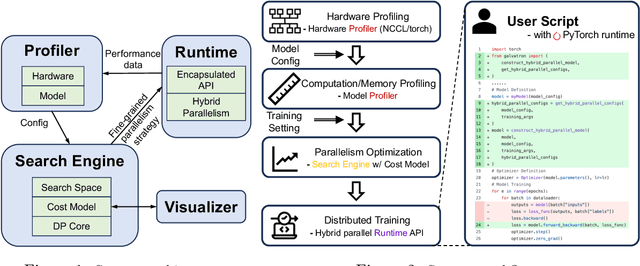
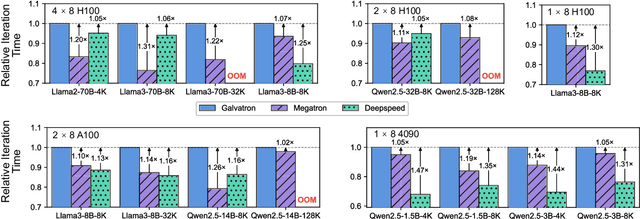
Abstract:Galvatron is a distributed system for efficiently training large-scale Foundation Models. It overcomes the complexities of selecting optimal parallelism strategies by automatically identifying the most efficient hybrid strategy, incorporating data, tensor, pipeline, sharded data, and sequence parallelism, along with recomputation. The system's architecture includes a profiler for hardware and model analysis, a search engine for strategy optimization using decision trees and dynamic programming, and a runtime for executing these strategies efficiently. Benchmarking on various clusters demonstrates Galvatron's superior throughput compared to existing frameworks. This open-source system offers user-friendly interfaces and comprehensive documentation, making complex distributed training accessible and efficient. The source code of Galvatron is available at https://github.com/PKU-DAIR/Hetu-Galvatron.
ByteScale: Efficient Scaling of LLM Training with a 2048K Context Length on More Than 12,000 GPUs
Feb 28, 2025Abstract:Scaling long-context ability is essential for Large Language Models (LLMs). To amortize the memory consumption across multiple devices in long-context training, inter-data partitioning (a.k.a. Data Parallelism) and intra-data partitioning (a.k.a. Context Parallelism) are commonly used. Current training frameworks predominantly treat the two techniques as orthogonal, and establish static communication groups to organize the devices as a static mesh (e.g., a 2D mesh). However, the sequences for LLM training typically vary in lengths, no matter for texts, multi-modalities or reinforcement learning. The mismatch between data heterogeneity and static mesh causes redundant communication and imbalanced computation, degrading the training efficiency. In this work, we introduce ByteScale, an efficient, flexible, and scalable LLM training framework for large-scale mixed training of long and short sequences. The core of ByteScale is a novel parallelism strategy, namely Hybrid Data Parallelism (HDP), which unifies the inter- and intra-data partitioning with a dynamic mesh design. In particular, we build a communication optimizer, which eliminates the redundant communication for short sequences by data-aware sharding and dynamic communication, and further compresses the communication cost for long sequences by selective offloading. Besides, we also develop a balance scheduler to mitigate the imbalanced computation by parallelism-aware data assignment. We evaluate ByteScale with the model sizes ranging from 7B to 141B, context lengths from 256K to 2048K, on a production cluster with more than 12,000 GPUs. Experiment results show that ByteScale outperforms the state-of-the-art training system by up to 7.89x.
Training-free and Adaptive Sparse Attention for Efficient Long Video Generation
Feb 28, 2025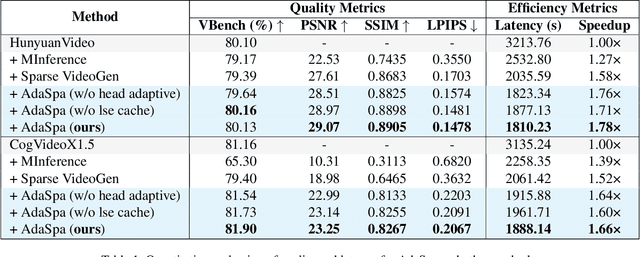
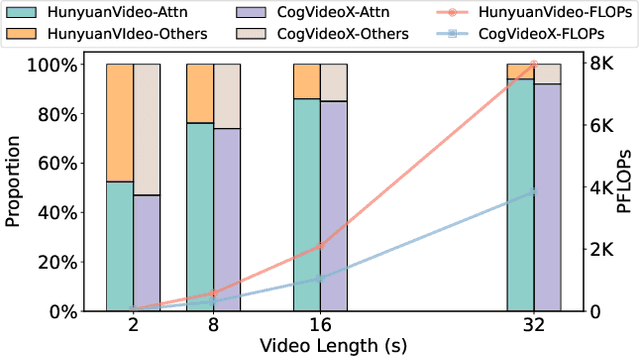
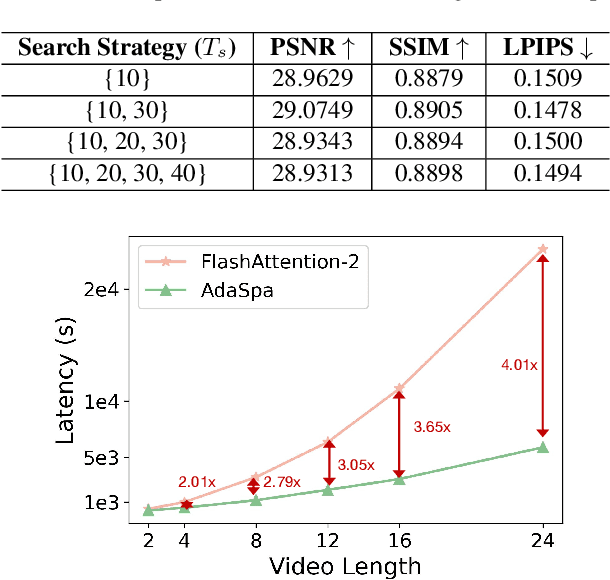
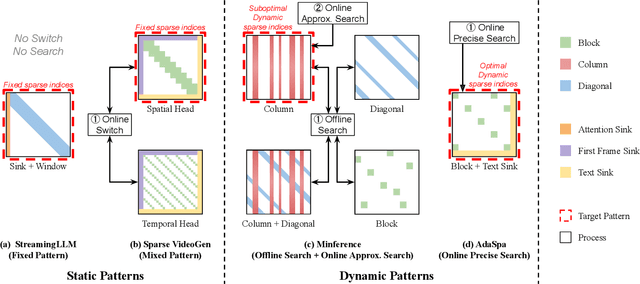
Abstract:Generating high-fidelity long videos with Diffusion Transformers (DiTs) is often hindered by significant latency, primarily due to the computational demands of attention mechanisms. For instance, generating an 8-second 720p video (110K tokens) with HunyuanVideo takes about 600 PFLOPs, with around 500 PFLOPs consumed by attention computations. To address this issue, we propose AdaSpa, the first Dynamic Pattern and Online Precise Search sparse attention method. Firstly, to realize the Dynamic Pattern, we introduce a blockified pattern to efficiently capture the hierarchical sparsity inherent in DiTs. This is based on our observation that sparse characteristics of DiTs exhibit hierarchical and blockified structures between and within different modalities. This blockified approach significantly reduces the complexity of attention computation while maintaining high fidelity in the generated videos. Secondly, to enable Online Precise Search, we propose the Fused LSE-Cached Search with Head-adaptive Hierarchical Block Sparse Attention. This method is motivated by our finding that DiTs' sparse pattern and LSE vary w.r.t. inputs, layers, and heads, but remain invariant across denoising steps. By leveraging this invariance across denoising steps, it adapts to the dynamic nature of DiTs and allows for precise, real-time identification of sparse indices with minimal overhead. AdaSpa is implemented as an adaptive, plug-and-play solution and can be integrated seamlessly with existing DiTs, requiring neither additional fine-tuning nor a dataset-dependent profiling. Extensive experiments validate that AdaSpa delivers substantial acceleration across various models while preserving video quality, establishing itself as a robust and scalable approach to efficient video generation.
Demystifying Workload Imbalances in Large Transformer Model Training over Variable-length Sequences
Dec 10, 2024Abstract:To optimize large Transformer model training, efficient parallel computing and advanced data management are essential. However, current methods often assume a stable and uniform training workload, neglecting imbalances in data sampling and packing that can impede performance. Specifically, data sampling imbalance arises from uneven sequence length distribution of the training data, while data packing imbalance stems from the discrepancy between the linear memory complexity and quadratic time complexity of the attention mechanism. To address these imbalance issues, we develop Hydraulis, which jointly optimizes the parallel strategies and data assignment. For one thing, we introduce large model training with dynamic heterogeneous parallel strategies in response to the sequence length variations within and across training iterations. For another, we devise a two-stage data assignment approach, which strikes a good balance in terms of the training workloads both within and across model replicas. Empirical results demonstrate that Hydraulis outperforms existing systems by 1.32-2.66 times.
Data-Centric and Heterogeneity-Adaptive Sequence Parallelism for Efficient LLM Training
Dec 02, 2024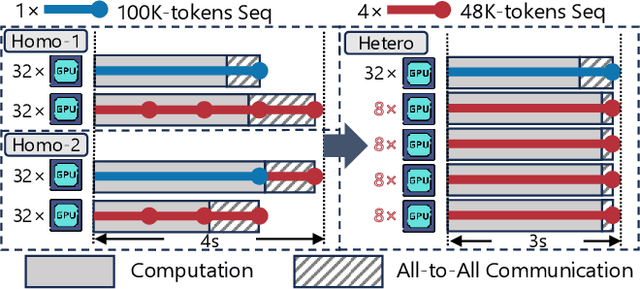
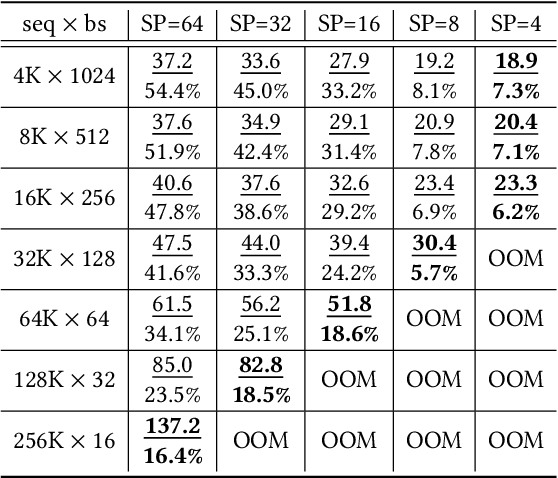
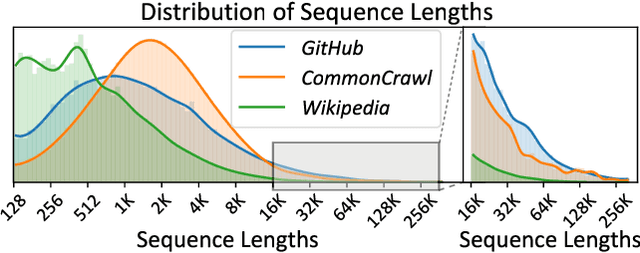
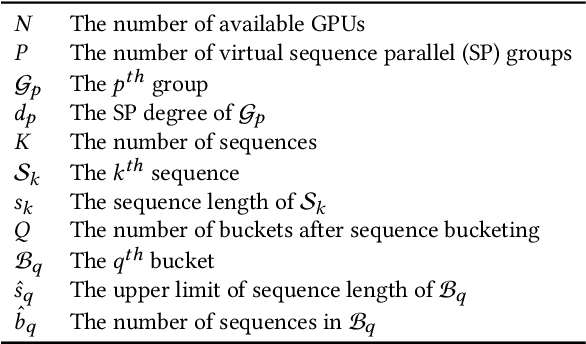
Abstract:Extending the context length (i.e., the maximum supported sequence length) of LLMs is of paramount significance. To facilitate long context training of LLMs, sequence parallelism has emerged as an essential technique, which scatters each input sequence across multiple devices and necessitates communication to process the sequence. In essence, existing sequence parallelism methods assume homogeneous sequence lengths (i.e., all input sequences are equal in length) and therefore leverages a single, static scattering strategy for all input sequences. However, in reality, the sequence lengths in LLM training corpora exhibit substantial variability, often following a long-tail distribution, which leads to workload heterogeneity. In this paper, we show that employing a single, static strategy results in inefficiency and resource under-utilization, highlighting the need for adaptive approaches to handle the heterogeneous workloads across sequences. To address this, we propose a heterogeneity-adaptive sequence parallelism method. For each training step, our approach captures the variability in sequence lengths and assigns the optimal combination of scattering strategies based on workload characteristics. We model this problem as a linear programming optimization and design an efficient and effective solver to find the optimal solution. Furthermore, we implement our method in a high-performance system that supports adaptive parallelization in distributed LLM training. Experimental results demonstrate that our system outperforms state-of-the-art training frameworks by up to 1.98x.
Gradual Learning: Optimizing Fine-Tuning with Partially Mastered Knowledge in Large Language Models
Oct 08, 2024



Abstract:During the pretraining phase, large language models (LLMs) acquire vast amounts of knowledge from extensive text corpora. Nevertheless, in later stages such as fine-tuning and inference, the model may encounter knowledge not covered in the initial training, which can lead to hallucinations and degraded performance. This issue has a profound impact on the model's capabilities, as it will inevitably face out-of-scope knowledge after pretraining. Furthermore, fine-tuning is often required to adapt LLMs to domain-specific tasks. However, this phenomenon limits the model's ability to learn and integrate new information during fine-tuning. The effectiveness of fine-tuning largely depends on the type of knowledge involved. Existing research suggests that fine-tuning the model on partially mastered knowledge-for instance, question-answer pairs where the model has a chance of providing correct responses under non-greedy decoding-can enable the model to acquire new knowledge while mitigating hallucination. Notably, this approach can still lead to the forgetting of fully mastered knowledge, constraining the fine-tuning dataset to a narrower range and limiting the model's overall potential for improvement. Given the model's intrinsic reasoning abilities and the interconnectedness of different knowledge areas, it is likely that as the model's capacity to utilize existing knowledge improves during fine-tuning, previously unmastered knowledge may become more understandable. To explore this hypothesis, we conducted experiments and, based on the results, proposed a two-stage fine-tuning strategy. This approach not only improves the model's overall test accuracy and knowledge retention but also preserves its accuracy on previously mastered content. When fine-tuning on the WikiQA dataset, our method increases the amount of knowledge acquired by the model in this stage by 24%.
Retrofitting Temporal Graph Neural Networks with Transformer
Sep 10, 2024



Abstract:Temporal graph neural networks (TGNNs) outperform regular GNNs by incorporating time information into graph-based operations. However, TGNNs adopt specialized models (e.g., TGN, TGAT, and APAN ) and require tailored training frameworks (e.g., TGL and ETC). In this paper, we propose TF-TGN, which uses Transformer decoder as the backbone model for TGNN to enjoy Transformer's codebase for efficient training. In particular, Transformer achieves tremendous success for language modeling, and thus the community developed high-performance kernels (e.g., flash-attention and memory-efficient attention) and efficient distributed training schemes (e.g., PyTorch FSDP, DeepSpeed, and Megatron-LM). We observe that TGNN resembles language modeling, i.e., the message aggregation operation between chronologically occurring nodes and their temporal neighbors in TGNNs can be structured as sequence modeling. Beside this similarity, we also incorporate a series of algorithm designs including suffix infilling, temporal graph attention with self-loop, and causal masking self-attention to make TF-TGN work. During training, existing systems are slow in transforming the graph topology and conducting graph sampling. As such, we propose methods to parallelize the CSR format conversion and graph sampling. We also adapt Transformer codebase to train TF-TGN efficiently with multiple GPUs. We experiment with 9 graphs and compare with 2 state-of-the-art TGNN training frameworks. The results show that TF-TGN can accelerate training by over 2.20 while providing comparable or even superior accuracy to existing SOTA TGNNs. TF-TGN is available at https://github.com/qianghuangwhu/TF-TGN.
Efficient Multi-Task Large Model Training via Data Heterogeneity-aware Model Management
Sep 05, 2024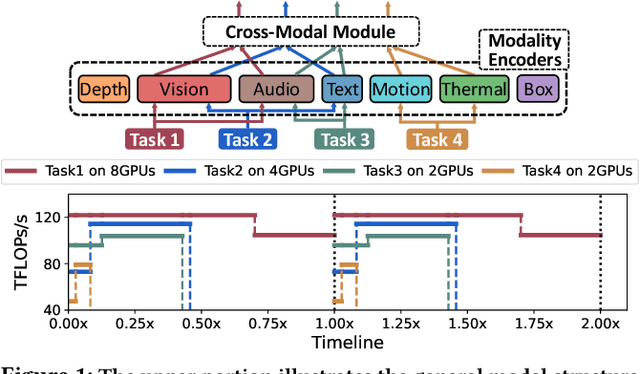
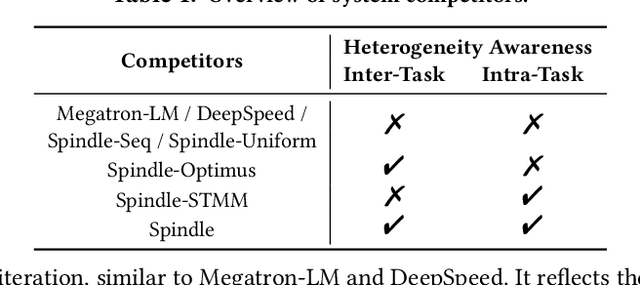
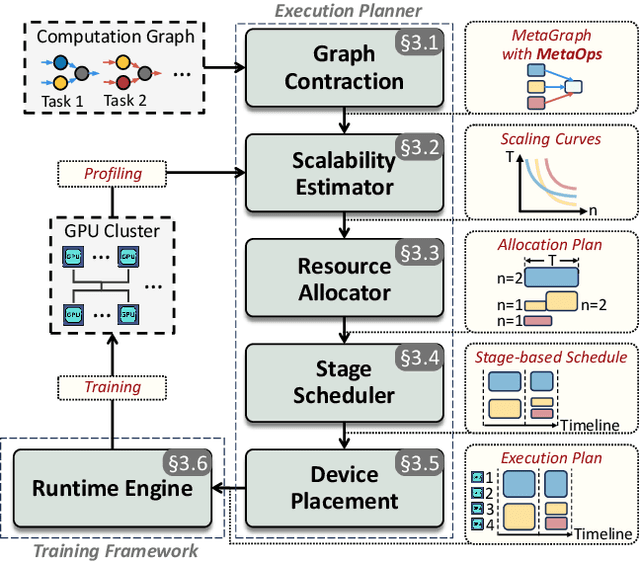
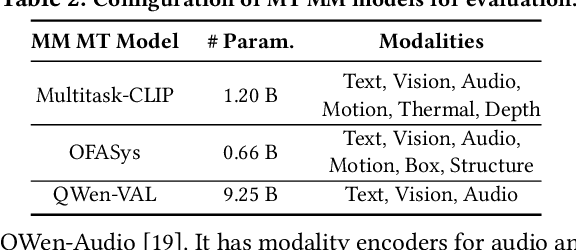
Abstract:Recent foundation models are capable of handling multiple machine learning (ML) tasks and multiple data modalities with the unified base model structure and several specialized model components. However, the development of such multi-task (MT) multi-modal (MM) models poses significant model management challenges to existing training systems. Due to the sophisticated model architecture and the heterogeneous workloads of different ML tasks and data modalities, training these models usually requires massive GPU resources and suffers from sub-optimal system efficiency. In this paper, we investigate how to achieve high-performance training of large-scale MT MM models through data heterogeneity-aware model management optimization. The key idea is to decompose the model execution into stages and address the joint optimization problem sequentially, including both heterogeneity-aware workload parallelization and dependency-driven execution scheduling. Based on this, we build a prototype system and evaluate it on various large MT MM models. Experiments demonstrate the superior performance and efficiency of our system, with speedup ratio up to 71% compared to state-of-the-art training systems.
 Add to Chrome
Add to Chrome Add to Firefox
Add to Firefox Add to Edge
Add to Edge